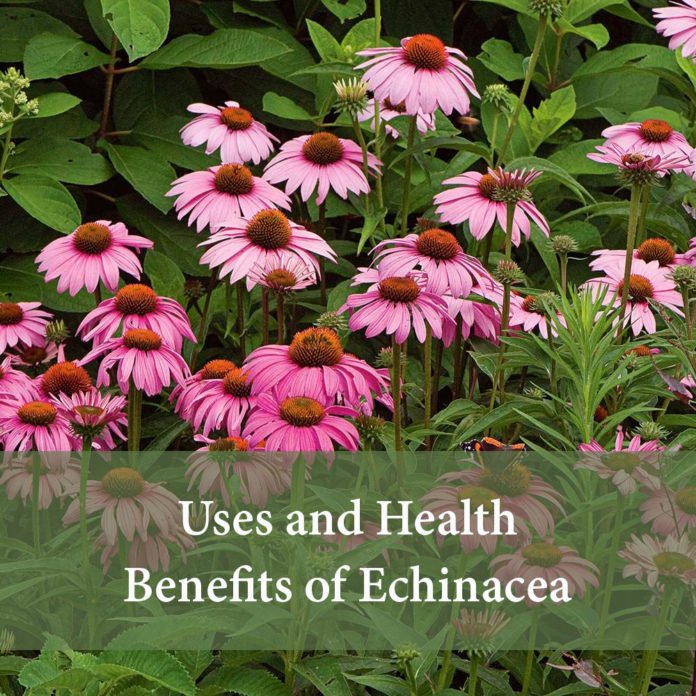Introduction
Ayurvedic herbs are an essential component of Ayurveda. Practitioners will usually use ayurvedic herbs for cleansing of the body, promote defense system against disease, and keep the body, mind, and spirit in balance.
Echinacea Purpurea
Echinacea Purpurea is a perpetual medicinal herb with important anti-inflammatory and immunostimulatory properties, especially used in the reduction of cold symptoms. One of its important uses is to promote healthy immune function. Although many of its traditional uses are related to topical applications. It is the most available dietary supplement in health food shops.
Scientific Classification
- Kingdom: Plantae
- Clade: Angiosperms
- Clade: Eudicots
- Clade: Asterids
- Order: Asterales
- Family: Asteraceae
- Genus: Echinacea
- Species: E. Purpurea
- Binomial name: Echinacea Purpurea
- Synonyms:
Brauneria purpurea (L.) Britton
Echinacea intermedia Lindl. ex Paxton
Echinacea speciosa (Wender.) Paxton
Helichroa Purpurea (L.) Raf.
Rudbeckia Purpurea L.
Description of Echinacea Purpurea
Echinacea, generally known as the purple coneflower which consists of fresh, aboveground parts, and harvested at flowering time, of Echinacea Purpurea.
Echinacea Purpurea, generally grows up to 120 cm (47 in) tall by 25 cm (10 in) wide at maturity. Depending on the environment, it grows throughout spring to late summer.
1. Flower
Flower heads are usually cone-shaped, but not always, purple in the wild. The single flowers (florets) inside the flower head are hermaphroditic, which have both male and female organs. It is fertilized by butterflies and bees. Flower heads may grow up to 4 inches (10.16 cm).
2. Leaves
The dark green leaves are hairy, opposite, entire, toothed, and lanceolate with three prominent veins. The narrow top leaves are attached to the stem with stalks. The lower leaves are bigger and emerge with the stem without a leaf stalk, and grow 8 in (20.32 cm) in length.
The plant develops deep, black, slender roots. Echinacea produces easily from seed or by root cuttings.
Chemical Constituents of Echinacea Purpurea Herb
Echinacea purpurea herb comprises:
- Caffeic acid derivatives: It includes cichoric acid (1.23.1% present in the flowers), chlorogenic acid and caftaric acid.
- Alkamides (0.0010.03%) : It mainly include isomeric dodeca-2E,4E,8Z,10E/Z-tetraenoic acid isobutylamides.
- Water-soluble polysaccharides: It includes PS I and PS II, fructans.
- Flavonoids ( 0.48%): It includes quercetin and kaempferol type (e.g., rutoside).
- Essential oil (0.080.32% ): That is composed of bornyl acetate, borneol, palmitic acid, pentadeca-8-en-2-one, and others.
Properties of Echinacea Purpurea Herb
Antiseptic, Stimulates Immune System, mild antibiotic, bacteriostatic, antiviral, anti-fungal.
Uses of Echinacea Purpurea Herb
The internal use of E. purpurea herb is considered as supportive therapy for colds, enlarged lymph glands, sore throat, and chronic infections of the lower urinary tract and respiratory tract. The external use of E. purpurea herb is for Wounds healing, skin regeneration and skin infections, psoriasis, eczema, inflammatory skin conditions, and chronic ulcerations. As a mouthwash, these are used for the treatment of sore throats tonsillitis, gum infections, and mouth ulcers.
-
- Positive Effect on the Immune System
Echinacea purpurea show its beneficial effects on the immune system. This plant may help to boost your immune system to fight against infections and viruses. This is the one and important reason why echinacea purpurea is used to treat the common cold.
-
- May Help Treat Skin Concerns
Some studies show that skincare products containing echinacea extract help to improve skin hydration and decrease wrinkles. Similarly, creams that contain Echinacea purpurea extract helps to improve symptoms of eczema and help to rejuvenate the skin’s thin, protective outer layer. However, echinacea extract seems to have a short shelf life, so it is difficult to add these extract in commercial skincare products.
-
- Anxiety
Some studies suggest that taking 40 mg of a specific echinacea extract per day for 7 days reduces anxiety. But less than 40 mg per day does not show effectively in anxiety.
-
- Tonsil inflammation (tonsillitis)
Some studies show that the use of echinacea into the mouth up to 10 times every two hours per day regular for up to 5 days improves sore throat symptoms. This is similarly used as a drug spray in people with tonsillitis.
-
- Eye inflammation (Uveitis)
Some studies show that using 150 mg of an echinacea product as an eye drops and a steroid twice daily, for 4 weeks treat inflammation of eyes. It does not improve vision.
The list of some of other Echinacea purpurea herb uses are below:
-
-
- Acid indigestion
- Attention deficit-hyperactivity disorder (ADHD)
- Chronic fatigue syndrome
- Diphtheria
- Dizziness
- Genital herpes
- Gum disease
- Malaria
- Migraine
- Pain
- Rattlesnake Bite
- Rheumatism
- Syphilis
- Flu
- Typhoid
-
Dosage Recommendations
There is currently no official dosage recommended for echinacea because studies of echinacea are highly variable.
The research has found the following doses to be effective in aiding immunity.
-
-
-
- Dry powdered extract: Take 300–500 mg of Echinacea purpurea, three times per day.
- Liquid extract tinctures: 2.5 ml, three times per day, or up to 10 ml every day.
-
-
So it is better to follow the instructions that are given with specific supplement. These recommended doses are for short term use, their long term use can show bad effects on the body.
Potential Side Effects
Echinacea products use are safe, effected and well-tolerated only for short-term use. For long term use, people can experience some side effects.
-
-
-
-
- Rashes
- Hives
- Itchy skin
- Stomach pain
- Swelling
- Shortness of breath
- Nausea
-
-
-
Contraindications
Contraindications for external use of Echinacea purpurea are not known.
Internal use of Echinacea purpurea is contraindicated in progressive systemic diseases, like tuberculosis, collagenosis, leukosis, and multiple sclerosis.
Parenteral administration is contraindicated in patients having allergies to Compositae (Asteraceae) members.
Precautions
Specific
Persons having allergies to the other members of the Asteraceae family should have to take caution while using Echinacea, due to the presence of Echinacea pollen.
General
People should be recommended to consult with a doctor before using these herbal products, especially in pregnancy, lactation or you are on other medication.


























